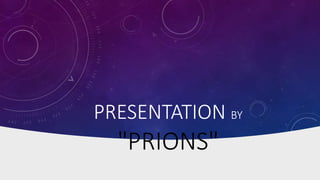
a new approach in processors technology
- 2. A NEW APPROACH IN PROCESSORS TECHNOLOGY "THINK NEW,BUILD NEW"
- 3. TEAM PRIONS: ANALYST AND PRESENTER: AYESHA NAZIR CHAUDRY G1F17BSCSOO90 DEVELOPER: ZARNISH CHOUDRY G1F17BSCS0099 DEVELOPER: RIMSHA VIRK G1F17BSCS0142
- 5. OUR SLOGAN "THINK NEW, BUILD NEW"
- 7. Today's processors are made from silicon but as it gets harder and harder to make ever more miniature circuits processor technology has moved from 90nm fabrication in the mid- 2000s to a barely believable 7nm now or even 5nm by 2021 – chipmakers are looking for alternatives; not just materials, but maybe even biological components.
- 8. PROBLEM: Modern processors have several billion transistors. That's been achieved by cramming ever more transistors into the same amount of silicon. but as you do that the laws of physics kick in and your processor starts generating heat. and the more power you want, the more heat you generate. but to achieve that you needed liquid nitrogen to stop them burning up.
- 9. SOLUTION 1: Use silicon in a different way For example, today's processors are largely flat. rather than try to cram ever more transistors into the same amount of space. we could take an architectural approach and build up to make the silicon equivalent of skyscrapers
- 10. SOLUTION 2: we could take what's known as a III-V approach. which uses elements from either side of silicon in the periodic table. Silicon is in group IV, so you'd use materials from groups III and V in layers above the silicon. This would reduce the amount of power needed to move electrons around, which should make it possible to manufacture transistors smaller and pack them in more tightly. The favourite candidate for III-V manufacturing is gallium nitride, which has been used in LEDs for a few decades and can operate at much higher temperatures than the previous favourite, gallium arsenide.
- 11. ANOTHER OPTION: RETHINK THE CPU ITSELF
- 12. Traditionally the CPU has done the difficult stuff while the GPU has handled the graphics. so for example in a game the CPU's doing the AI. but the GPU's ability to do simpler tasks in massively parallel ways means designers are increasingly looking at sharing the overall workload between CPU and GPU based on their suitability for the job. The more the GPU can do the better, because GPUs are massively parallel circuits, They have thousands of cores compared to the handful in a CPU. Unlike CPUs, which are already pushing the limits of miniaturisation, GPUs have a long way to go before the laws of physics ruin their exponential growth.
- 13. CARBON DATING: • What if silicon runs out of road? • Carbon could come to the forefront instead, in the form of carbon nanotubes. • IBM published a paper in the journal Science describing a new method for creating carbon nanotubes from sheets of the "miracle material" graphene. • Unlike previous attempts, IBM's method didn't encounter increasing electrical resistance as contact sizes were reduced. IBM says that we may see carbon nanotube processors "within the decade". • Better transistors can offer higher speed while consume less power. Plus, carbon nanotubes are flexible and transparent. They could be used in futuristic 'more than Moore' applications, such as flexible and stretchable electronics or sensors
- 14. GO ORGANIC: • In 2011, researchers in Belgium created a plastic microprocessor by printing 4,000 plastic transistors on flexible plastic foil. • It's hardly a Core i7 – it can run one program consisting of 16 instructions – but while it isn't very powerful, it's very cheap. • And if research into roll to roll or sheet to sheet printing pays off, it could get cheaper still • processors would be printed using organic 'inks'.
- 15. DIFFICULTIES: For that to happen, though, we'd need to get much more accurate organic printers . while silicon processors head for single digits in the nanometre scale, lab-scale printing is still working in micrometres.
- 16. PHOTONIC PROCESSORS: One of the most promising alternatives to silicon is to create optical or photonic computers based on light. In late 2015, researchers at the University of Colorado-Boulder, MIT and Berkeley made a breakthrough: they combined photonic circuitry and electronic circuitry on a single chip. "It's the first processor that can use light to communicate with the external world," said project lead professor Vladimir Stojanović. "No other processor has photonic I/O in the chip."
- 17. QUANTUM COMPUTING: • Last but not least, there's quantum computing. • Google's working on it and the first working quantum processor was built at Yale in 2009, but it's exceptionally hard to explain. • Quantum computers aren't binary like traditional ones, where 0 is off and 1 is on. Quantum numbers can exist in multiple states at the same time, which means quantum computers could consider multiple options simultaneously. In a 64-bit quantum computer, each 64-bit register is capable of holding 18,446,744,073,709,551,616 different values at the same time. If you were to carry out some computation, it would therefore be carried out on all those values at once. • There's an astonishing amount of money being spent on quantum computing research by organisations and governments, but for now it remains a far away if rather tantalising possibility.